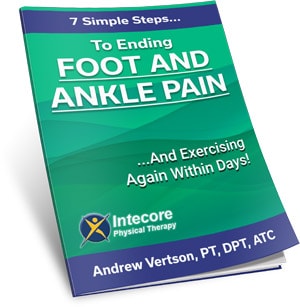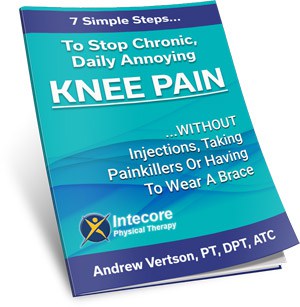
Is walking good for foot tendonitis? It’s a question many people ask when they’re dealing with the discomfort and pain that comes with this condition. As a physical therapist, I often see patients who are unsure about how much activity they should engage in when managing foot tendonitis. Walking, a simple and natural form of exercise, can be both beneficial and potentially harmful depending on how it’s approached.
In this blog, we’ll explore the effects of walking on foot tendonitis, discussing both the benefits and the risks. You’ll learn when walking can be helpful, how to do it safely, and what signs to look for that might indicate it’s time to rest. Plus, we’ll cover additional treatment options and tips to ensure you’re taking the best care of your feet. By the end, you’ll have a clearer understanding of how to manage your foot tendonitis while staying active and healthy. So, let’s dive in and find out if walking is the right step for you!
More Posts Like This From Intecore Physical Therapy:
Sprained Ankle vs Broken Ankle: How to Tell the Difference and Get Back on Your Feet
5 Ways To Alleviate Foot Pain When Walking
Do The Shoes You Wear For Running Actually Matter?
Table of Contents
What Is Foot Tendonitis?
Foot and ankle tendonitis is an inflammation or irritation of the tendons in your foot. Tendons are the strong, fibrous tissues that connect muscles to bones, and they play a crucial role in helping you move. When these tendons become overused or injured, they can become swollen and painful.
The most common causes of foot tendonitis include repetitive stress from activities like running, walking long distances, or standing for extended periods. It can also result from wearing improper footwear or experiencing an injury. Symptoms typically include pain and tenderness in the affected area, swelling, and stiffness, especially after physical activity.
If left untreated, foot tendonitis can worsen, leading to chronic pain and more serious issues that can interfere with your daily activities.
When Walking Can Be Beneficial for Foot Tendonitis Pain
Walking can actually be good for managing foot tendonitis if done correctly.
Start by ensuring your walking form is proper: keep your back straight, shoulders relaxed, and stride naturally. Avoid over-striding, as this can put extra stress on your tendons. Aim for a smooth, heel-to-toe motion with each step to reduce impact on your feet.
The right footwear for foot tendonitis is important to stop it from getting worse. Choose shoes that provide good arch support, cushioning, and a snug fit to help reduce strain on your tendons – must running shoe shops can help you with this.
Avoid high heels or flat, unsupportive shoes and consider using orthotic inserts for added support and shock absorption.
If you’re returning to walking after a break, start slowly. Begin with short, gentle walks and gradually increase your distance and pace as your comfort level improves. Listen to your body and avoid pushing through pain. A gradual approach helps your tendons adjust and strengthens them over time, reducing the risk of further injury to tendonitis of the foot and ankle.
Signs That Walking Is Aggravating Your Foot Tendonitis
It’s important to listen to your body. If you notice increased pain, swelling, or stiffness after walking, these are signs that walking might be aggravating your tendonitis. Sharp or persistent pain during or after your walks indicates that your tendons need rest and further activity might worsen the condition.
Low-Impact Alternatives to Walking:
If walking is causing discomfort, consider switching to low-impact alternatives. Swimming and cycling are excellent options that allow you to stay active without putting additional stress on your feet. These activities can help maintain your fitness and promote recovery while giving your tendons the break they need.
Tips for Walking with Foot Tendonitis
The Importance of Warm-Up and Stretching:
Before you start walking, take a few minutes to warm up and stretch. Gentle stretching helps prepare your muscles and tendons for activity, reducing the risk of injury. Focus on stretching your calves, hamstrings, and feet to improve flexibility and circulation.
Creating a Balanced Walking Schedule:
Establish a walking schedule that balances activity with rest. Start with shorter walks and gradually increase the distance and intensity as your comfort level improves. Ensure you have rest days in between to allow your tendons to recover.
Monitoring Symptoms and Adjusting Your Routine:
Keep track of how your feet feel before, during, and after your walks. If you experience pain or discomfort, adjust your routine accordingly. Reduce the distance, slow down your pace, or take an extra rest day if needed.
Additional Treatment Options
How Physical Therapy Can Help
Physical therapy is an effective treatment for managing tendonitis. We work with you to provide you with tailored exercises to strengthen the muscles and tendons around your feet, improving your flexibility and reducing pain. We also teach you proper walking techniques for your body and recommend supportive footwear or orthotics to help manage your condition.
Quick Recap
Walking can be beneficial for foot tendonitis if done correctly, but it’s important to pay attention to your body and avoid aggravating the condition. Proper technique, supportive footwear, and a gradual increase in activity can help manage symptoms and promote recovery.
With the right approach, walking can be a safe and effective part of your recovery plan. Warm up properly, follow a balanced schedule, and monitor your symptoms to ensure you’re taking the best care of your feet. And don’t forget to explore low-impact alternatives if needed.
Ready To Get Help With Physical Therapy?
If you’re dealing with foot and ankle pain or tendonitis – we’re here to help. Reach out today to schedule your first step towards a pain-free life by calling us here: 949-597-2103
Not quite ready to speak on the phone? We understand that taking the first step can be daunting. That’s why we offer our Free Ankle Pain Tips Guide. It’s packed with practical advice and simple tips to help you start managing your ankle pain right now, from the comfort of your home.
Download your free guide today

- Can Physical Therapy Help You Avoid Surgery? - August 1, 2025
- 7 Ways to Get Rid of Tension Headaches Naturally - July 1, 2025
- Why Are My Feet Swollen? Common Causes Explained - June 2, 2025













